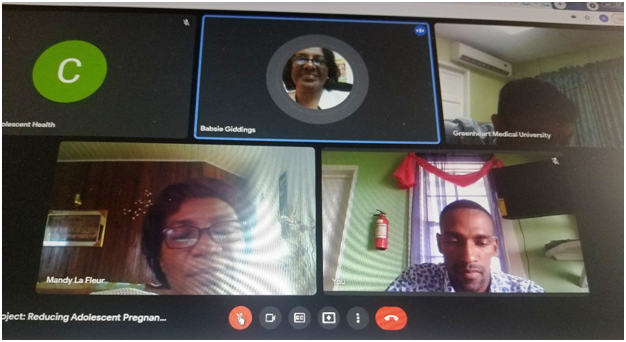
Tuesday, June 9th, 2021, marked the 2nd anniversary of the signing of the agreement between the Government of Guyana and the United Nations Population Fund (UNFPA); for the India UN Development Partnership Fund (UNDPF) project titled ‘reducing adolescent pregnancy in Guyana’. To mark the occasion, a virtual joint UNFPA – Ministry of Health in Guyana meeting was held to allow for discussions on the status of the project’s implementation as well as to secure agreements on required steps to solidify the gains of the project and to aid sustainability of project interventions beyond the project period.
In attendance were: Dr. Narine Singh, Chief Medical Officer of the Ministry of Health in Guyana; Ms. Cilandell Glen, Coordinator of the Adolescent Health Unit within the Ministry of Health in Guyana; Mr. Adler Bynoe, UNFPA Liaison Officer for Guyana, within the UNFPA Sub-Regional Office for the Caribbean; Ms. Babsie Giddings, Sexual & Reproductive Health (SRH) Officer under the India funded project in Guyana; and Dr. Mandy La Fleur, Adolescent Health Standards Consultant under the India funded project in Guyana.
During these discussions, it was acknowledge that the development and rollout of the Standards for Quality Health Care Services for Adolescents in Guyana – a component of the UNFPA executed project – provides a unique opportunity to operationalize a sustained monitoring and evaluation infrastructure for quality adolescent health care in Guyana, inclusive of quality adolescent sexual and reproductive health care.

Image of meeting participants on June 9, 2021
Guyana has the highest rate of adolescent pregnancy in the English-speaking Caribbean. Persons aged 10-24 account for the largest proportion (31%) of the population. The adolescent fertility rate is estimated at 74 births per 1,000 girls aged 15-19 - well above the Caribbean average of 60.2; with Administrative Regions 1,7, and 9 in Guyana and having unacceptable high rates and indigenous girls experiencing the highest rates among all ethnic groups. The India funded project aims to improve the availability of and access to quality sexual and reproductive health information and services (including commodities) for adolescents. The project also aims to empower communities, parents and adolescents to prevent adolescent pregnancy in Administrative Region 1 (Barima – Waini) and Administrative Region 9 (Upper Takatu – Upper Essequibo) in Guyana.
Administrative Region 1 and Administrative Region 9 are rural areas in Guyana and home to many Indigenous communities. The goal is to reduce adolescent pregnancy in these two Regions by 10% by the end of 2021; thereby aiding Guyana’s efforts to realise Goals 3 (Good Health & Well-Being), 5 (Gender Equality), and 10 (Reduced Inequalities) of the Sustainable Development Goals (SDGs). It is worth noting that Guyana has ten Administrative Regions. The India funded project seeks to target adolescents aged 10 to 19 in Region 1 (Barima - Waini) and Region 9 (Upper Takutu - Upper Essequibo), two rural regions in Guyana. The choice of Regions 1 and 9 allows the project to cover the two regions in Guyana where women reported the lowest use of contraceptives.

Image of Administrative Regions of Guyana

Image of Adolescent pregnancies and rates in Guyana by region (2015-2016)

Image of some of the banners displayed in front of the target health care facilities
[1] CARICOM. (2014). CARICOM Integrated Strategic Framework for the Reduction of Adolescent Pregnancy in the Caribbean; and UNFPA Sexual & Reproductive Health Thematic Brief, available on the UNFPA website at <https://caribbean.unfpa.org/en/news/sexual-reproductive-health-thematic…;
[3] PAHO/WHO. (2018). Situation Analysis of Adolescent Pregnancy in Guyana.
[3] UNICEF. (2017). Study on Indigenous Women and Children in Guyana, UNICEF. Available online at: <https://www.unicef.org/guyana/SitAn_on_Ameridian_Woman_and_Children_-_F…;





